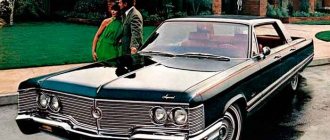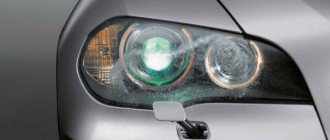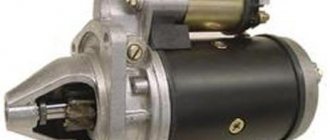LED headlights, like any other revolutionary headlights for their time, before the advent of laser headlights, were considered the most effective source of lighting, which is still actively used by automakers in their cars. By the way, today not all auto giants can afford the serial production of LED headlights; as a rule, premium-segment cars are equipped with such headlights.
With laser headlights everything is even more complicated and confusing; these headlights are an achievement of high technology, and their creation requires special conditions and a lot of different electronics, which actually create the laser beam . Leading manufacturers of automotive lighting optics such as Osram, Philips, Valeo, Bosch and Hella are actively working in this area.
In addition to leading manufacturers of lighting sources, automakers are very interested in laser headlights. Thus, in 2011, laser headlights were introduced by BMW, which demonstrated its own achievements in this area on its concept, codenamed i8. Anyone who follows events at BMW remembers how, a few years later, the concept turned into a full-fledged production supercar.
Characteristics
Laser headlights are the next step in development in automotive lighting technology, which will soon replace almost completely the existing classic types of headlights (xenon or halogen). This type of lighting is significantly different from solar and all artificial sources. Despite the illumination range of 500-600 meters, it is safe for the eyes and does not interfere with other road users, since the fluorescent material creates a white glow that is as close in color to daylight as possible, which means that it is not capable of dazzling or interfering with traffic .
The use of such headlights allows you to save energy by 2-3 times, when compared with the same diode ones; laser ones are compact (size about 10 microns), thanks to which headlights on cars began to be made much smaller, while maintaining efficiency.
Laser headlights are safe for the eyes
Headlights of the near future: xenon, LEDs or laser
In our last publication , we traced the long path of automotive lighting from kerosene stoves and bright carbide lamps to the familiar halogen lamps with diffusers.
But already in the 90s it became clear where to move next. And it was possible to move towards reducing energy costs and increasing brightness. After all, even lensed optics with conventional incandescent lamps no longer met modern requirements. And then gas-discharge light sources, long used in stationary lighting, came forward to fight the darkness.
Xenon: powerful, complex and expensive
Among the people, the name “xenon” is firmly attached to such headlights, although, strange as it may sound, they have nothing to do with xenon arc-discharge lamps. The enormous power and good spectrum given the poor efficiency of arc lamps turned out to be unnecessary, and what we used to call “xenon” is actually a metal halide lamp, inside of which a mixture of gases burns. It sometimes uses xenon gas as one of the ingredients, but often does without it.
The efficiency of this solution is more than sufficient - 80-100 lumens per watt of power, and the spectrum of emitted light turned out to be one of the best and most natural. For comparison: a regular halogen provides 13-15 lumens per watt, a gas-filled one - about 10, and a regular vacuum - about 8.
No other types of gas-discharge lamps could compete with them; even sodium lamps with an output of up to 200 lumens per watt did not pass strict selection due to the limited light spectrum. Their yellow light might not be reflected from some surfaces, and such objects would appear dark, and road safety is no joke.
There were two main difficulties in introducing gas-discharge lamps. Firstly, in order to ignite an arc inside the bulb, a voltage of about 25–50 thousand volts is required. Secondly, the entire volume of gas glows inside the flask, and this light must be very clearly directed in the right direction.
The second problem was perfectly solved by floodlight (lensed) optics, which was already discussed above. Well, the development of electronics has successfully dealt with the first problem. In 1991, the Hella company, which, by the way, started with the production of acetylene lamps, began selling the first sets of serial “xenon” for cars. This was a very expensive option for the BMW 7 Series E32.
Unlike conventional lamps, which are powered directly from the on-board power supply, xenon is powered through the so-called ballast or ignition unit.
As we have already said, when starting a gas discharge, a voltage pulse of 25 thousand volts or higher is needed, and after starting it is necessary to accurately withstand the current. Simply holding the voltage is useless - the lamp changes its resistance greatly as it warms up. So the ignition unit is a very complex and expensive part of the lamp; it is responsible both for its quick “ignition” and for its durability (when the current fluctuates, the electrodes inside the bulb burn out, and the lamp must be replaced).
As we already said, HID (i.e. “xenon”) headlights are very efficient and produce 80-100 lumens per watt. With a standard 35-watt power consumption, this lamp produces a lot of light. In addition, it heats up very little and does not have a fragile filament, which means its service life is longer and it is not afraid of vibrations.
The highest efficiency values apply to sources of very “cold” light with a light temperature above 5,500 Kelvin - this is a characteristic bluish glow. Lamps with a light temperature of 3,500 or 2,700 Kelvin that is more comfortable for the eye have lower efficiency, but there is still a gap between them and conventional incandescent lamps in efficiency and luminous flux power.
The downside of all these advantages is the high cost of equipment, which manufacturers have not yet managed to “win.” For example, an original ignition unit for a Volvo S80 II will cost 14-17 thousand, and for a Volkswagen Passat B6 - 17-18 thousand. Moreover, cheaper analogues do not always exist.
Design and principle of operation of laser headlights
It is necessary to begin with the fact that such headlights are most correctly called laser-phosphor, and not just laser. The design of this type is not complicated: it consists of several laser diodes, which, in turn, illuminate the phosphor, which converts the received energy into light radiation, due to which a powerful beam is formed, which is 1000 times more intense than even a diode beam. Also, the resulting beam is coherent and monochrome, which means it has a constant wavelength and phase difference. Its power is 170 lumens.
The beam is initially blue, and to achieve brightness it must pass through a phosphor coating, which scatters the laser beam, producing powerful light.
Therefore, in this case, it is important to understand that the laser itself does not illuminate the road, but only produces the necessary energy.
The head laser light works in conjunction with a computer, which, using special sensors, monitors the appearance of oncoming cars and pedestrians and allows them to avoid blinding them. The Dynamic Light Spot system detects obstacles while driving, drawing the driver's attention to them using more intense light, which helps to prepare in advance for the necessary maneuvers and actions.
The design of this type of headlights is not complicated
Modifications
While laser headlights are being tested for the first time, the operating principle of which has not yet been perfected, some Audis are already installing additional lamps that use a similar operating principle. Installed together with fog lights, they operate on the principle of illuminating road obstacles that can pose a serious danger to a vehicle moving at high speed. In particular, BMW uses such laser headlights to prevent collisions.
The principle of operation of the device is quite simple - first, a person or other living creature of sufficiently large size (for example, a deer) is detected, which makes it possible to capture thermal radiation at a great distance. It tracks its position in real time and transmits a signal to special laser “search lights” installed in the same unit as the fog lamps. In turn, they create a fairly narrow beam of radiation, which makes it possible to illuminate a “living obstacle” and thereby prevent an accident with fatal consequences. On average, such “search lights” allow you to gain 1–5 seconds in detecting a living creature on the road
- it seems like this is not much, but it is worth remembering that a car moving at high speed can travel more than a hundred meters in this time.
There are also options that are installed as headlights - however, the significant drawback that such laser headlights have is the price, which is several times higher than that of LED devices. In addition, on highways with a lot of traffic, electronics do not always have time to react in time to changes in the road situation, as a result of which the enormous brightness of laser headlights can become a disadvantage due to blinding oncoming traffic. Therefore, we will see laser light sources used as the main ones on modern cars only after a few years. In the meantime, laser headlights will remain the domain of conceptual new products presented at international exhibition centers.
Advantages and disadvantages
Advantages:
- Compact design;
- Saving energy consumption (consumes almost 30% less than classical sources);
- High spatial coherence;
- Large (about 600 meters) and clear lighting range, thanks to the use of high technology;
- The possibility of glare is eliminated, since the direction of light is focused to one point;
- Automatic shutdown of diodes if a person or any living creature enters the lighting area;
- High intensity and power of lighting;
- Interaction with pedestrians;
- Indication of vehicle dimensions when driving in cramped conditions;
- Limiting the direction of the light beam thanks to microcontrollers.
Such headlights are economical in energy consumption
Flaws:
- High price. Today, this type is the most expensive automotive light source.
- Fragility of the structure.
Manufacturers
There are two categories of laser headlight manufacturers. On the one hand, such technologies are quite naturally mastered directly by car manufacturers. The most successful developments in the segment are demonstrated by Audi and BMW. True, laser optics still rarely appears in mass models - such equipment is more often acquired as an optional solution. And on the other hand, laser headlights are produced by advanced developers of LED technology. We can note the companies Philips, Osram and Hella, which occupy leading positions in the field of designing the latest lighting systems. What is especially interesting is that in both categories, companies occupy highly specialized niches, promoting unique technological solutions.
Which ones are better to choose?
Today, laser headlights are installed only on premium cars and are not sold as a separate spare part, the main reason for this is the high cost, as well as the very expensive cost of replacement or repair.
Therefore, of course, those who can afford them in the future will not regret the purchase even once, because this will be the most optimal solution.
In the meantime, when choosing light for your car, it is recommended to choose diode headlights that have the best technical characteristics and an affordable price that fully corresponds to the quality.
As for xenon and halogen ones, these types have long outlived their usefulness and have many disadvantages that will result in many problems and financial costs for the driver.
Negative reviews
Obvious advantages still do not exclude the negative aspects of using laser headlights. The disadvantages are caused by the same features that LEDs have. Thus, users note that in some situations the light is excessively blinding to oncoming drivers and is generally unusual, which can distract other motorists. In addition, in existing modifications, laser headlights are very expensive and this is an important point, considering that their advantages are not always vital.
When to expect?
Experts in the field of car electronics say that laser headlights are still prototypes that can only be used in the most expensive cars. However, even they have not yet been developed to perfection - in particular, the main drawback remains the problem of blinding drivers of oncoming traffic. However, it is quite obvious that such light sources are the future of car headlights, since with similar energy consumption they provide much greater operating efficiency, and, therefore, . As for serial use, engineers say that it will be possible to create relatively inexpensive laser headlights in 5–10 years.
In 2008, the Audi R8 became the world's first production car with all-LED headlights, followed by innovative dynamic turn indicators in 2012. A new chapter in the history of the automotive industry was opened by Audi in 2013, when Matrix LED headlights were introduced on the updated Audi A8 model. Now the brand with four rings on the Audi R8 LMX model shows a laser emitter that forms the high beam. This technology improves the lighting range, which is ideal for the Audi R8 LMX sports car.
When developing lighting technology, Audi engineers work together with colleagues from the sports division. For example, the combination of LED and laser sources to form the high beam will be used for the first time on the new Audi R18 e-tron quattro racing prototypes during the 24 Hours of Le Mans on June 14-15. This continues the brand's four-ring tradition: sporting events become a testing ground for new technologies intended for use in production vehicles.
In a laser high beam headlight, the laser module emits a beam of light that reaches twice as far as LED headlights. Each module consists of four high-power laser diodes. With a diameter of just 300 micrometers, they generate a blue laser beam with a wavelength of 450 nanometers. The phosphorus converter converts this radiation into traffic-use white light with a color temperature of 5,500 Kelvin, creating ideal conditions for the human eye to perceive.
It allows the driver to perceive contrasting details more easily and prevents fatigue. The light beam, which is activated at speeds from 60 km/h, complements the LED high beam modules of the Audi R8 LMX and significantly increases visibility and safety. An intelligent system with a video camera monitors the presence of other road users and automatically adjusts the distribution of light flux, eliminating the possibility of dazzling them.
The Audi R8 is a flagship sports model, similar in design to racing cars. The Audi R8 LMX is offered as a coupe and will be limited to 99 units. With a power of 570 hp. and developing a torque of 540 Nm, its 5.2-liter V10 engine is capable of accelerating the car to 100 km/h in just 3.4 seconds.
The new flagship model stands out thanks to its exclusive Ara Blue finish with a crystal effect. A large rear spoiler with fixed geometry increases downforce on the rear axle. It is made of reinforced carbon fiber with a matte finish. The lower front spoiler, side air intake linings, engine compartment lid, exterior mirror housings, side fairings, rear wing and diffuser are made from the same material.
The folding sports seats are trimmed in fine Fine Nappa leather with diamond stitching in Sepang Blue. The harmony of the interior is emphasized by light touches. Matte carbon fiber is used in the finishing of the central tunnel and the parking brake lever.
The Audi R8 LMX will hit European roads in the summer of 2014. In Germany, prices will start from 210,000 euros. The quota for Russia is limited to a few cars; the price will be announced at the start of sales - in the 4th quarter of 2014.
True, BMW is challenging Audi's leadership in laserization. You can understand the Munich residents: the Vision ConnectedDrive conceptual roadster, equipped with laser optics, debuted back in 2011 at the Geneva Motor Show. In addition, sales of a serial BMW with progressive high beam will soon start - advanced “spotlights” will be installed as an option on the i8 hybrid sports car. The car is planned for sale in Russia and will be shown at the Moscow Motor Show.
Laser headlights are high-tech light optics that are on the wish list of all advanced car enthusiasts. Everyone knows that these devices protect drivers from accidents and are quite convenient in foggy times, but they also have some disadvantages. Read more about this below.
[Hide]











